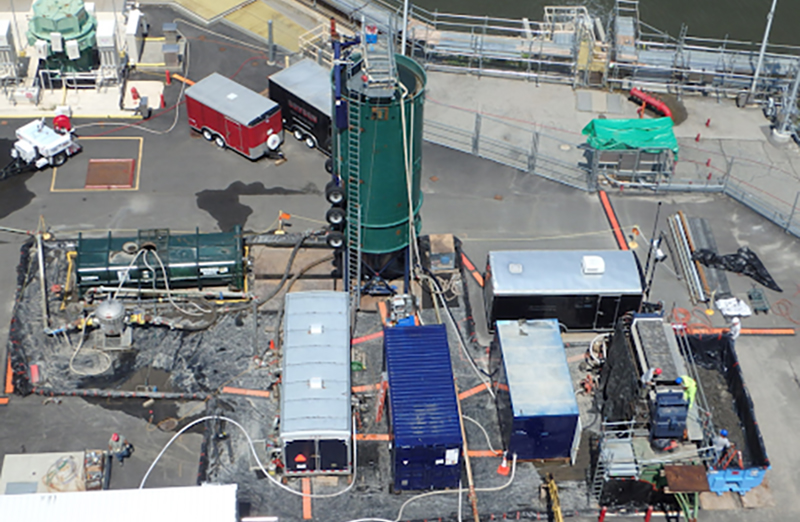Fossil-fuel and nuclear power plants all critically rely upon an adequate supply of processing and cooling water to safely and effectively operate within their facilities. Periodic water intake sediment removal requires careful coordination with diving service contractors, such as Underwater Construction Corporation (UCC – www.uccdive.com), and specialty slurry processing contractors, such as Underwater Mineral Processing Services (UMPS – www.mpsmaine.com), for integrated on-site sediment dredging/dewatering/water treatment operations. Adding the complexity that the removed sediments contain radionuclides such as cesium, thorium, and potassium makes the challenge more interesting!
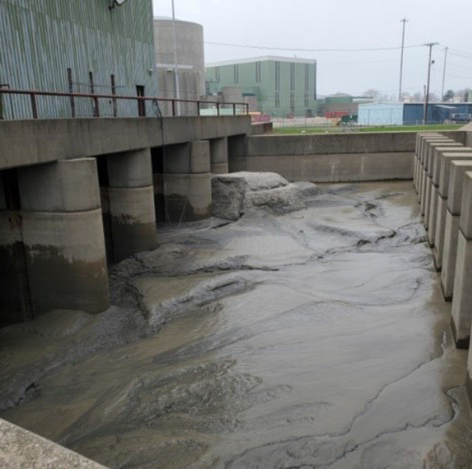
The Challenge: A confidential nuclear power plant experienced decreased cooling water flow within the intake channel and screen structure. This event triggered the power plant’s priority response plan to secure an integrated turnkey solution for the removal, dewatering, and off-site disposal of sediment containing Cs-137*, Th-228* & K-40*.
The preliminary underwater ultrasonic survey images estimated approximately 420 cubic yards of sediment removed, as shown in the example sonar image below.
The Solution: The approach requires nuclear-certified surface-supplied divers operating a three-inch diameter suction vacuum hose, each at approximately 450 gallons/minute (GPM). The vacuum-dredged slurry is conveyed to the UMPS turnkey system, providing on-site processing for sediment dewatering and
excess dredge water treatment. The radionuclide-contaminated slurry received from diver dredging at 900 GPM contained an average of 10,000 mg/l total suspended solids.
UMPS performed on-site flocculation/sedimentation jar tests on sediment slurry samples thereby screening a variety of different polymers for the best performing chemical flocculation program.
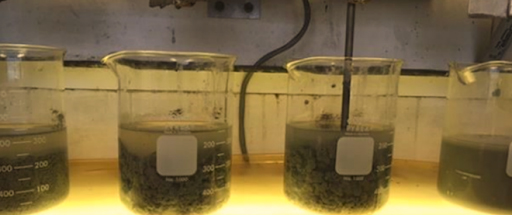
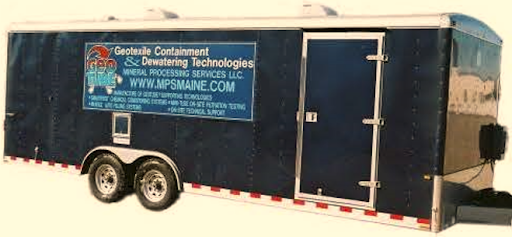
The UMPS SmartFeed® slurry processing unit continuously measured the flow and solids content of the diver-delivered dredged slurry, adjusting the polymer feed addition every seven seconds in response to variations in flowrates and percent slurry solids content, chemically conditioning the slurry. The photo below shows the location of the UMPS SmartFeed®, High-rate Clarifier/Paste Thickener, Plate & Frame Filter Press and Cake Box.
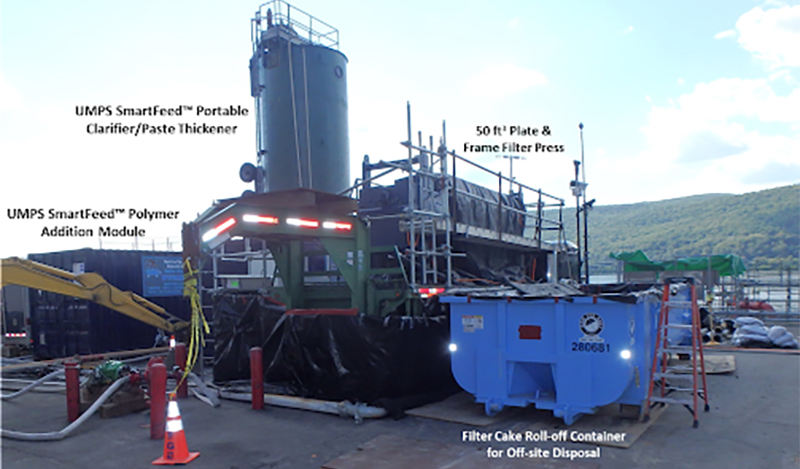
The conditioned slurry underwent water/solids separations using a transportable High-rate Clarifier/Paste Thickener. The effluent, containing < 3 ppm TSS, was pumped to a flash mix tank and ion-exchange zeolite resin bed to remove solubilized radionuclides. Integrated float-level operated high-pressure pumps that controlled the intermediate tank level to 10-micron filter cartridges discharged zero total suspended solids with ≤ 10 Bq/Kg detectable radionuclides.
The UMPS High-Rate Clarifier/Paste Thickener underflow solids averaged 32% dry solids. The slurry was pumped to a fifty cubic foot recessed chamber filter press, dewatering the cake to an average of 62% dry solids.
Due to constraints on the available laydown area at the power plant, the UMPS turn-key diver vacuum dredge sediment slurry dewatering and water treatment operations were confined to a footprint measuring approximately 50 feet x 75 feet as shown in the photo below.
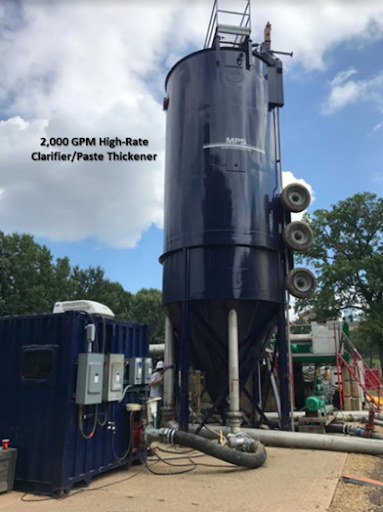

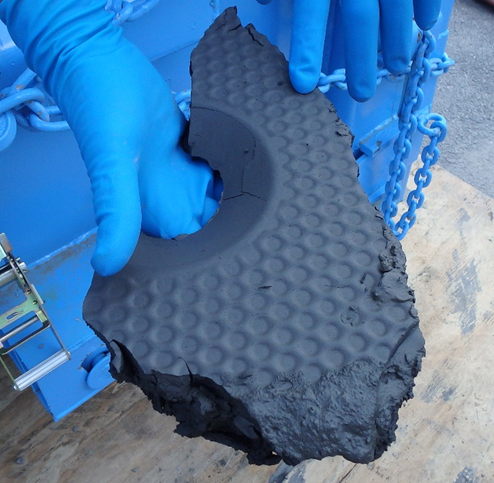
To reduce the radionuclide content of the dewatered filter cake and dramatically reduce the cost of off-site disposal, UMPS developed washing of the initially dewatered filter cake within the filter press using an acidic water solution. The lowered pH of the cake wash solution dramatically increased the radionuclide’s solubility. Following this washing step, the radionuclide detection in cake wash was ≤ 10 Bq/Kg. The photo below shows the “washed” filter press cake exhibiting a 72% dry solids moisture content.
The High-rate Clarifier/Paste Thickener treated overflow and the filter cake wash water were sent through 10-micron cartridge filters and then passed through ion-exchange resin bed filters containing resins designed explicitly for Cs 137, Th-288, and K40 absorption. Treated effluent collected in a QA/QC tank for customer on-site radiological department verification before being released from the process under the power plant’s NRC license. The spent ion-exchange resin bed was manifested for regulated disposal.
The Outcome: UMPS turnkey sediment/water turnkey processing system permitted the diver slurry pumping operations to operate continuously.
The previous contractor’s earlier processing efforts using a batch process operation only allowed diving dredging to be performed for one hour each day.
The table below presents the reduction in radioactivity of the filter cake wash being reduced to 6 Bq/Kg.
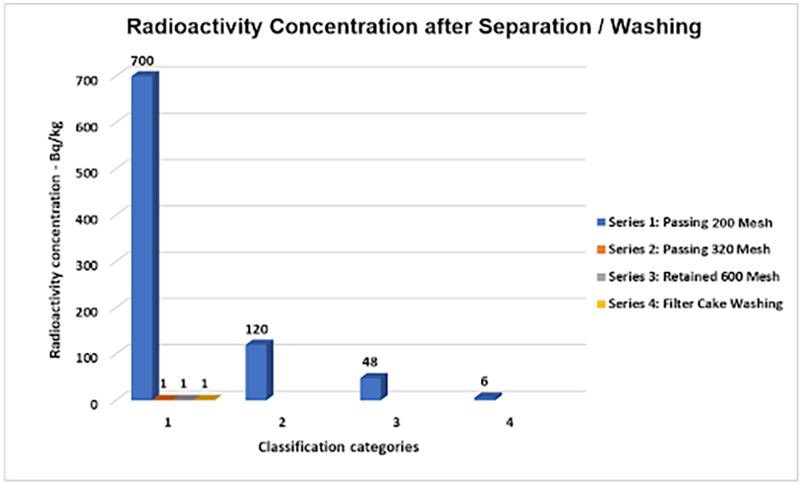
The UMPS SmartFeed® process had analytical protocols with real-time graphical displays integrated into its operation. UMPS’ provision of daily, real-time data results with the power plant’s radiological department gained their confidence that UMPS’ treatment goals were safely removing years of sediment buildup around the plant’s water intakes and restoring full flow capacity.
UMPS provides complete turnkey project design, underwater imaging, regulatory permitting support, hydraulic dredging, commercial diving, sediment processing, and water treatment. For additional details on UMPS’ dredge slurry processing services, visit the UCC/UMPS blog, SEDIMENT / SLUDGE DREDGING & DEWATERING SERVICES
If you have a potential dewatering project that UMPS can assist with, please visit “Spec Your Project“ at https://mpsmaine.com/spec-your-project/. Send us the completed form, and you will hear from us soon! Need a quick response? Contact Jim Meagher at 207.741.2955 / [email protected] or “Contact Us“ for any of your pits, pond, or lagoon sludge/sediment dredging and dewatering services.
